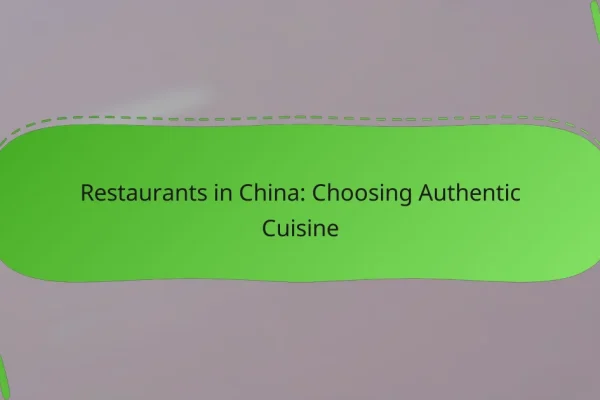What are the best dining experiences in China?
The best dining experiences in China include a variety of culinary adventures that highlight the country’s rich food culture. From vibrant street food scenes to elegant fine dining, each region offers unique flavors and dining styles that are worth exploring.
Street food tours in Beijing
Beijing’s street food tours provide an immersive experience into local cuisine, showcasing dishes like jianbing (savory pancakes) and baozi (steamed buns). These tours often guide you through bustling markets and alleyways, allowing you to taste authentic flavors while learning about the history behind each dish.
When participating in a street food tour, consider joining a guided group to ensure you visit reputable vendors. Prices typically range from CNY 100 to CNY 300 per person, depending on the length and inclusions of the tour.
Fine dining in Shanghai
Shanghai boasts a vibrant fine dining scene, featuring both traditional Chinese and modern fusion cuisine. Restaurants like Ultraviolet by Paul Pairet offer multi-sensory dining experiences, while establishments such as Din Tai Fung are renowned for their exquisite xiaolongbao (soup dumplings).
Reservations are often recommended, especially for popular spots, and expect to spend anywhere from CNY 500 to CNY 2,000 per person for a full meal, depending on the restaurant’s prestige and menu selections.
Traditional tea ceremonies in Hangzhou
Hangzhou is famous for its Longjing tea, and participating in a traditional tea ceremony here provides insight into Chinese tea culture. These ceremonies often involve multiple steps, including tea selection, brewing techniques, and tasting, emphasizing the artistry behind tea preparation.
Look for tea houses that offer guided ceremonies, which can cost around CNY 150 to CNY 400 per person. This experience not only allows you to enjoy high-quality tea but also to learn about its cultural significance.
Dim sum in Guangzhou
Guangzhou is the birthplace of dim sum, making it a must-visit for enthusiasts. Dim sum restaurants often serve a variety of small dishes, from dumplings to buns, typically enjoyed with tea. The experience is communal, encouraging sharing and sampling of multiple dishes.
Many dim sum restaurants operate on a cart system, allowing diners to choose dishes as they pass by. Prices can vary, but expect to pay around CNY 200 to CNY 500 for a satisfying meal that includes several dishes and tea.
What are the most popular Chinese cuisines?
The most popular Chinese cuisines reflect the diverse culinary traditions across the country, each with unique flavors and cooking techniques. Key styles include Cantonese, Sichuan, Shandong, and Huaiyang, each offering distinct dishes and ingredients that showcase regional specialties.
Cantonese cuisine
Cantonese cuisine is known for its emphasis on fresh ingredients and subtle flavors. Dishes often include stir-fried vegetables, seafood, and dim sum, which are small plates served in steamer baskets. Popular items like char siu (barbecue pork) and wonton noodles highlight the balance of taste and texture characteristic of this style.
When dining in Cantonese restaurants, look for dishes that feature seasonal produce and local seafood to experience the cuisine at its best. Dim sum is typically served during brunch hours, making it a great option for social gatherings.
Sichuan cuisine
Sichuan cuisine is famous for its bold flavors, particularly the use of chili peppers and Sichuan peppercorns, which create a unique numbing spiciness. Signature dishes include mapo tofu and kung pao chicken, which are rich in flavor and often feature a variety of spices and aromatics.
To fully appreciate Sichuan cuisine, consider trying hot pot, where diners cook their own ingredients in a spicy broth. Be prepared for intense flavors, and if you’re sensitive to spice, ask for milder options.
Shandong cuisine
Shandong cuisine is recognized for its emphasis on seafood and the use of vinegar to enhance flavors. This style often features dishes such as sweet and sour carp and various soups, showcasing techniques like braising and frying. The cuisine is known for its freshness and the quality of its ingredients.
When exploring Shandong cuisine, seek out restaurants that specialize in seafood dishes, as they often highlight the region’s coastal resources. Pairing meals with local wines can enhance the dining experience.
Huaiyang cuisine
Huaiyang cuisine is celebrated for its delicate flavors and artistic presentation, often focusing on freshwater fish and seasonal vegetables. Dishes like braised pork and various dumplings exemplify the meticulous cooking techniques that define this style. The cuisine is known for its balance of taste and visual appeal.
To enjoy Huaiyang cuisine, look for restaurants that emphasize traditional cooking methods and fresh ingredients. The presentation of dishes is as important as their taste, so take time to appreciate the artistry involved in each meal.
How to choose a restaurant in China?
Choosing a restaurant in China involves considering local reviews, hygiene ratings, and the authenticity of the cuisine. These factors can significantly enhance your dining experience and ensure you enjoy quality food.
Consider local reviews
Local reviews provide valuable insights into the dining scene in China. Websites and apps like Dianping and Meituan are popular platforms where users share their experiences and ratings of restaurants.
Look for restaurants with a high number of positive reviews, as this often indicates consistent quality. Pay attention to comments about specific dishes, as they can guide your choices.
Check for hygiene ratings
Hygiene ratings are crucial for ensuring food safety in Chinese restaurants. Many cities display hygiene scores prominently, often based on inspections by local health authorities.
A score of 90 or above is generally considered acceptable. If you notice a low rating, it may be best to choose another establishment to avoid potential health risks.
Look for authentic cuisine
Authenticity in cuisine can greatly enhance your dining experience in China. Seek out restaurants that specialize in regional dishes, as they often use traditional ingredients and cooking methods.
For example, if you’re in Sichuan, look for places that serve spicy hot pot or mapo tofu. Avoid tourist traps that offer generic dishes, as they may not reflect the true flavors of Chinese cuisine.
What are the dining etiquette rules in China?
Dining etiquette in China is essential for showing respect and building relationships. Key rules include using chopsticks correctly, understanding seating arrangements, and adhering to toasting customs.
Using chopsticks properly
Using chopsticks is a fundamental part of dining in China. Hold them about two-thirds of the way up, using your thumb, index, and middle fingers to manipulate them. Avoid sticking chopsticks upright in rice, as this resembles a funeral ritual.
When not in use, place chopsticks on the rest provided or across your bowl, rather than on the table. This shows respect for the meal and the host.
Understanding seating arrangements
Seating arrangements are significant in Chinese dining culture, often reflecting hierarchy and respect. The guest of honor typically sits opposite the host, while senior family members or elders are given priority seating.
When invited to a meal, wait for the host to indicate where you should sit. It’s polite to allow elders to take their seats first, and you should not move your chair until everyone is seated.
Respecting toasting customs
Toasting is an important ritual in Chinese dining, symbolizing goodwill and respect. The host usually initiates the first toast, and it’s customary to raise your glass slightly higher than others to show deference.
When toasting, maintain eye contact and say “Ganbei,” which means “dry the cup.” Avoid crossing arms while toasting, as this can be seen as disrespectful. Remember to take small sips after toasting, as it’s a sign of appreciation for the gesture.
What are the regional specialties across China?
China’s diverse culinary landscape features unique regional specialties that reflect local ingredients, traditions, and flavors. Each region boasts signature dishes, making the exploration of Chinese cuisine a rich and varied experience.
Peking duck in Beijing
Peking duck is a renowned dish from Beijing, celebrated for its crispy skin and tender meat. Traditionally served with thin pancakes, hoisin sauce, and sliced scallions, it offers a delightful combination of textures and flavors.
When enjoying Peking duck, it’s common to watch the chef carve the duck tableside, enhancing the dining experience. A full duck typically serves several people, making it ideal for sharing during gatherings or special occasions.
Hot pot in Sichuan
Hot pot is a popular dining style in Sichuan, characterized by a simmering pot of broth where diners cook various ingredients at the table. The experience is interactive, allowing guests to customize their meals with a selection of meats, vegetables, and noodles.
Sichuan hot pot is known for its bold flavors, often featuring spicy broth infused with Sichuan peppercorns. Diners should be prepared for a range of spice levels and can balance the heat with dipping sauces made from sesame oil, garlic, and vinegar.












